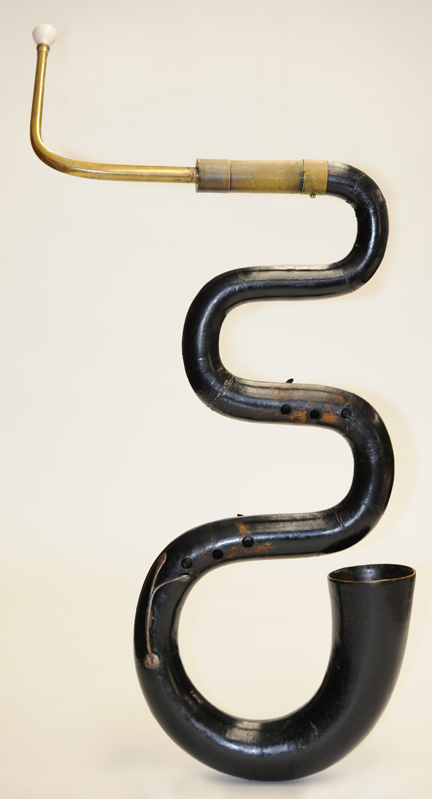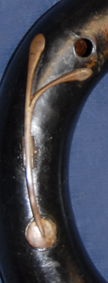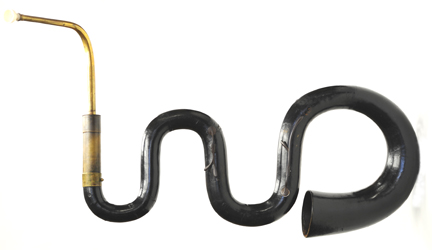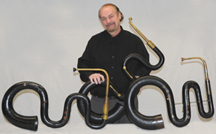

 hurch
hurch  erpent in C by Forveille,
erpent in C by Forveille,
Paris (signed 1821), 3 keys
"The Lumsden Serpent"
This instrument belonged to Alan Lumsden of the London Serpent Trio and was used in the premiere performance in 1989 of the Concerto for Serpent by Simon Proctor, written for Alan Lumsden and considered the first concerto for serpent. Restored by Christopher Monk, the crook’s end of the horn was damaged, and a metal mount was added that served to lengthen the instrument’s air column. While the serpent centers at A=440, its proportions and length without the metal endpiece suggest that the instrument could have either been pitched in D or C=460. Presently, we know of no other serpent d’eglise made by Forveille; this instrument is signed and dated 1821. The swallowtail keywork permits the instrument to be played in either a horizontal or vertical position (British or French style). Two rear thumbkeys have been placed on the instrument for either horizontal or vertical playing, and the front key may be played by either the right index finger (British style) or the right pinky finger (French style).
to download
a high density image
Please include the following photo credit in any public presentation:
photo courtesy of Berlioz Historical Brass


front key
[third key]
DIMENSIONS
Measurements of air column with the instrument pitched at A=440
Sounding length: crook and body excluding mouthpiece: 2140 mm
Placement of keys/toneholes from the mouthpiece end:
1st key: 1111 mm
1st tonehole: 1194 mm
2nd tonehole: 1232 mm
3rd tonehole: 1275 mm
2nd key: 1467 mm
4th tonehole: 1608 mm
5th tonehole: 1654 mm
6th tonehole: 1699 mm
3rd key: 1829 mm
External diameter at base of the instrument: 86 mm
Internal bell diameter at the end of the air column: 117 mm
Wall thickness at the end of the air column: 60 mm
Tonehole diameter
(surface opening; measurements do not take into account undercutting):
1st tonehole: 13 mm
2nd tonehole: 13 mm
3rd tonehole: 13 mm
4th tonehole: 14 mm
5th tonehole: 14 mm
6th tonehole: 14 mm
Impressions of playing characteristics: This instrument’s second octave mid-range is quite flat. I must vent the 2nd octave F; however, the 2nd octave G centers beautifully with all toneholes closed and the 2nd octave A (with the first tonehole closed) proves to be the most resonate note on the instrument (and the most resonate 2nd octave A that I have ever encountered on a serpent). The first octave fingering is conventional with normal pitch variations easily accessible. The 3rd octave fingering is idiosyncratic according to the player, the mouthpiece, and the bore humidity and temperature.

1821 Forveille signing

rear side of the serpent

“Please note that these photographs and measurements are given freely to members of the research community. I own the three instruments and maintain copyright and, officially, property rights of these images.” Craig Kridel, 2006
For those individuals who wish to use images in commercial publications,
copyright release will be freely granted; however, please contact the photographer
Craig Kridel, craigkridel@mindspring.com.
exploring the role of
early 19th century brass
Piccolo Press : ITEA Historical Instrument Section : The Tigers Shout Band : Harmoniemusik : Links